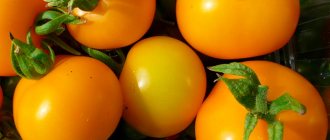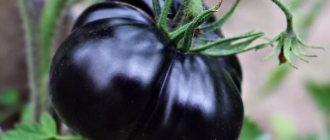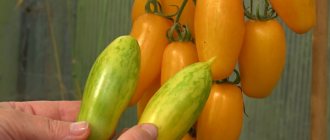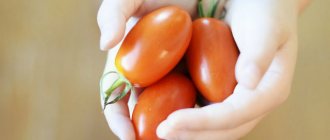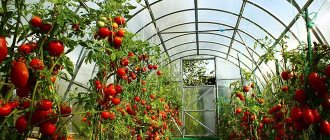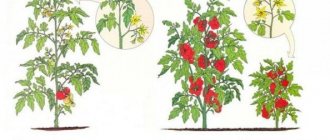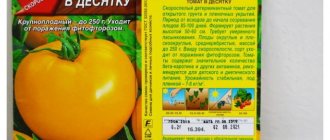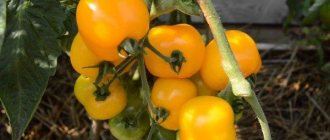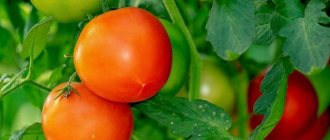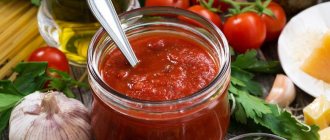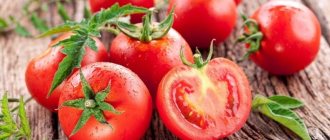The best varieties of tomatoes for the Leningrad region
According to the State Register classification, the Leningrad region belongs to the North-Western region and the first light zone. The climate is characterized by high air and soil humidity, frequent rains, short and cool summers. In such conditions, it is possible to grow tomatoes with short ripening periods, which have shade tolerance and immunity to fungal diseases, which often develop in conditions of high humidity. And there are such varieties - they can be found in the State Register. Let us give brief characteristics of some of them.
Table: the best determinate varieties for open ground
| Variety | Ripening time, days | Productivity | Fruit weight, g | Color | Taste | Purpose |
| Ground Gribovsky 1180 | 96—112 | 173–420 c/ha | 55–90 | Red | Satisfactory and good | Salad |
| White filling 241 | Early ripening | 275–814 c/ha | 80—130 | Good | Universal | |
| Baltic | 4.2 kg/m2 | 166 | Salad | |||
| Flash | 85—95 | 4.8 kg/m2 | 80—110 | Great | Universal | |
| Otradny | 92—102 | 251–489 c/ha | 50—68 | Good and excellent | Salad | |
| Chanterelle | Mid-early | 9.1 kg/m2 | 110—130 | Orange | Great | Universal |
Photo gallery: tomatoes for open ground
Tomato Ground Gribovsky - an old proven variety
Baltic tomato is used for salads
White filling tomato has a universal purpose
Tomato Flash - super early variety
Tomato Otradny has equal fruit sizes
Chanterelle tomato fruits have an original shape
Table: the best varieties for the greenhouse
| Variety | Growth type | Ripening time, days | Productivity, kg/m2 | Fruit weight, g | Color | Taste | Purpose |
| Pink beauty | Determinant | 97 | 6 | 150 | Pink | Great | Salad |
| Rosy cheeks | 110—112 | 5,5 | 180—260 | ||||
| Northern beauty | Indeterminate | 120 | 4,1 | 62—120 | |||
| Bear in the north | Determinant | Early ripening | 11 | 120 | Red | Good | |
| Fighter | 95 | 2,3 | 67—88 | Universal | |||
| Chukhloma | Indeterminate | 111—118 | 7,9—9,6 | 110—120 | Orange | Great |
Photo gallery: tomatoes for the greenhouse
Tomato Fighter has a second name - Buyan
Tomato Mishka ripens early in the north
Tomato Rosy cheeks has an excellent taste
Tomato Northern Beauty is indeterminate
Chukhloma tomato has excellent taste and beautiful fruit shape
Determinate varieties of tomatoes are limited in growth by the formation of a flower cluster at the top.
Indeterminate varieties have unlimited growth, which stops only with the end of the growing season.
Tomatoes for the north of Siberian selection
Siberian varieties of tomatoes are suitable for vegetable growers to grow. They are not afraid of fairly low temperatures. Adapted for short daylight hours.
The immune system will protect against typical diseases that affect nightshades in protected soil conditions.
They produce high yields no worse than varieties intended for cultivation in warm regions. The section contains the best representatives of tomatoes. Gardeners, summer residents and gardeners advise planting them on your site at least once.
Siberian surprise
The variety bred by Siberian breeders has the following characteristics:
- Excellent fruiting in closed soil conditions and in unprotected soil.
- Adaptation to cold weather conditions.
- Limited shoot growth.
- High level of productivity.
- Early fruit ripening.
- Resistance to viral diseases.
The bush produces from 8 to 10 kg per season.
King of Siberia
It is not for nothing that the representative of the nightshade family received such a name. Large fruits grow on bushes with green leaves. The bright yellow color makes them attractive and appetizing. Under the thin skin lies a juicy and elastic pulp. It tastes no worse than vegetables intended for growing in sunny regions.
Sensei
An early ripening variety of Siberian selection. The tomato harvest period begins very early. Inside the fruit there is a pulp of incredible taste. Tomatoes are intended for fresh consumption. Sensei's bushes are low, but powerful and strong.
a great warrior
The vegetable can confidently be classified as an early ripening representative. Planting the Great Warrior in a heated greenhouse will allow you to harvest along with the tomatoes that were planted in February. The growing season does not exceed 95 days.
Raspberry-colored fruits grow on a tall and powerful stem. There are practically no seeds in the fleshy part. The weight of one tomato is also surprising - 450-550 g.
Growing conditions
To successfully grow tomatoes in the Leningrad region, certain conditions must be created.
In the open ground
Tomatoes need warmth and good light, which is a problem in this area. Before you begin preparing a bed without shelter, you should choose the most suitable location. It must meet the following conditions:
- Be level and well lit.
- Have protection from cold winds and drafts. These could be the walls of buildings, fences, tall, dense trees located on the north side of the garden bed.
- Be located at some elevation, excluding swampiness and stagnation of moisture.
- Have loose, permeable soil, rich in humus and with an acidity close to neutral. The optimal level is pH 6.5-7.0. Soils that do not meet these requirements will require improvement.
If the soils on the site are heavy (which is quite likely in this region), then in the fall it is worth loosening them by any available means. To do this, peat, sawdust, coarse sand, etc. are added to the digging. Fertilizers should also be applied at the same time:
- humus or compost (10–20 kg/m2);
- wood ash (2–3 l/m2);
- superphosphate (40-60 g/m2).
If it is necessary to deoxidize the soil, dolomite flour or fluff lime is also added at a rate of 0.5–1 kg/m2.
Warm beds
In cold regions (including the Leningrad region), warm beds are often used for growing vegetables. Let us briefly recall the process of their preparation:
- According to the size of the beds, they dig a hole 30-40 cm deep. You can do without a hole by arranging high beds, for which you install a fence around their perimeter from scrap materials (boards, slate, tiles, etc.).
- A layer of old boards, bars, thick branches and other similar coarse organic matter is placed at the bottom.
- The second layer is placed with organic residues of middle fractions - corn stalks, coarse wood chips, vegetable tops, etc.
The second layer is placed with organic residues of middle fractions - corn stalks, coarse wood chips, vegetable tops, etc.
- Fallen leaves, shavings, sawdust, and hay are used as the third layer.
- All this is sprinkled with chernozem (5-7 cm), watered with water with the addition of preparations containing soil bacteria (Siyanie, Baikal, Vostok, etc.), and also treated with Fitosporin to prevent fungal diseases.
- For the winter, the bed is covered from washing out with film, roofing felt, slate, etc.
Such beds can also be arranged in greenhouses - this will bring the planting time closer.
Table: conditions for growing tomatoes in a greenhouse
| Index | Normative value | What is controlled | Consequences of non-compliance | How to adjust |
| Illumination | Intensity - 20 thousand lux; Daylight hours: 12-14 hours | Luxmeter | Plants stretch out and become weak | Installation of special lamps. Amateurs often use fluorescent lamps, housekeepers and LED phytolamps |
| Temperature | +18—25 °C | Thermometer | At temperatures below +15 °C growth stops, at elevated temperatures (more than +30-32 °C) pollen is sterilized | To increase - heating using heating devices, for example, fan heaters, and to decrease - ventilation |
| Air humidity | 65—70% | Hygrometer | High humidity provokes fungal diseases, low humidity provokes pollen desiccation. | To increase the humidity in the room, place containers with water; to lower it, ventilate it. |
Video: advice from experts on growing tomatoes in the North-West region (57 minutes)
Variety of varieties and hybrids for the Siberian region
The main merit of breeders is the emergence of tomato varieties of different ripening periods. Thanks to the painstaking work of scientists, the first fruits from tomato bushes can be obtained without waiting for autumn. There are tomato varieties for the North-West that are not just early ripening, but ultra-early ripening, which begin to bear fruit at the end of June.
Tomato Riddle - early ripening baby
Reviews of the Riddle tomato inform about the unusually early ripening of fruits; it begins in just 85 days. This variety will appeal to lovers of dishes with tomatoes who do not want to wait patiently for the autumn tomato abundance. Productivity is low, but other positive qualities compensate for this minus:
- the miniature size of the plant, its “height” is only 40-50 cm, allows you to place from 6 to 8 bushes in a small bed the size of a square meter;
- the developed stem is stable without additional support, the type is determinate;
- the fruits ripen all of the same size, as chosen - round, red, weighing 80-90 grams (in a greenhouse up to 100 g).
Tomatoes in a bunch of 4-6 pieces. Another interesting feature, without which the description of the Riddle tomato would be incomplete, is the attractive absence of “extra” stepchildren. Stable resistance to most diseases has also been observed.
Boni MM is not a tomato, but just a song
Close to the Riddle in terms of early ripening, these are the reviews of the Boni MM tomato from the experience of gardeners. It is harvested already 2.5 months after seed germination. In the southern regions they even refuse to prepare seedlings, the agricultural technology of this variety of nightshade is so simple.
Impressive bunches averaging 80 grams each on a miniature bush 50-55 cm tall are a common sight. The plant does not cause any trouble either in tying it up or in pinching it. Flat-round fruits of bright red color, good taste. Harvest – 1.5 -2 kg.
If desired, this unpretentious bush can be grown on a windowsill or balcony in the summer.
Seemingly and invisible tomatoes from the Siberian garden
In the line of “Siberian Garden” varieties, the tomato is apparently invisibly distinguished by its ability to set 15 to 20 fruits of different sizes on the clusters. There really are a lot of tomatoes on one bush. If you leave 5-6 clusters for fruiting, the harvest will be approximately 4 kg. Tomatoes are round in shape, and their weight varies from 50 to 300 grams. The ripening process is uneven and lasts about a month. Given that this species is classified as an early species, it should be expected that tomatoes will be collected from the bush until the very last moment of the plant’s life. The description of the Visibly Invisible tomato was first recorded in 2001 by Siberian scientists. According to the type of cultivation, it is classified as medium-sized determinate.
Yamal grows both in the garden and on the balcony
The description of the variety and characteristics of the Yamal tomato are very familiar to all fans of the early compact representatives of nightshade crops:
- a determinate, truly tiny bush reaches only 40 cm, and this is in a greenhouse (on the ground it is 25-35 cm);
- on a site of 1 sq. m are perfectly adjacent to 6-8 plants of the species;
- From one bush you get about 1.5 kg of tomatoes;
- Harvest time: 85 days from sowing.
For such miniature tomatoes, the yield indicators are record high. In the phase of biological maturity, the fruits are beautiful red in color with a strong skin. The taste is excellent, sweet and sour. High dry matter content (4-5%).
In the top decorative tomatoes, reviews of the Yamal tomato elevate it to the leaders. This plant has an irresistible visual appeal during the fruiting period, when it is hung with tomatoes of different shades and sizes. Will decorate any loggia. It will grow without problems on the windowsill in the kitchen. Very convenient - picked from the bush and immediately into the salad.
Tomatoes without labor and hassle
At the beginning of the second decade of the 21st century, reviews appeared about the Lazy Siberian Garden tomato, an early ripening hybrid of the first generation. The product of selection by Siberian creators is characterized by increased cold resistance, which is what they wanted from it. Determinate, standard type. Usually the height of the bush does not exceed 60 cm. Compact, well-leafed, productive, early ripening type of tomato. The heart-shaped fruits are raspberry-red in color. Weight from 300 to 400 grams. For a plant of such a structure, the load of harvest is an unbearable burden; without securing it to a peg, the stem can break. Siberian scientists have created a variety that is distinguished by its unpretentiousness coupled with resistance to a host of diseases.
From a variety of tomatoes with potato leaves
A tomato with a potato leaf, this description of the Yablonka tomato in Russia is inherited along with the seeds by many generations of gardeners in our country. The determinate standard plant grows tall, about 100 cm. Thanks to many years of work on improving the variety and without unnecessary work on the formation of the bush, it produces a consistently high yield of small spherical fruits of about 100 grams. Sweet and sour taste common to tomatoes, universal use in cooking. The fruits of this variety have a mid-early ripening period, after 3.5-4 months. If it is autumn with early frosts, the harvested unripe tomatoes “arrive” in boxes without loss of taste and quality.
Peach on a nightshade bush
The small oblong-round tomato Shaggy Bumblebee resembles a peach with its velvety fluffy skin. On one bush 3-5 kg of pubescent pink-red tomatoes ripen. The time from immersion of seeds in the soil to the first ripe tomatoes is about 120 days. The bush is standard, with a final growth point.
First generation hybrid Server F1
The early ripening hybrid tomato Server F1 is classified as determinant. The relatively small height (60 cm) and compactness of the plant determine the love of farmers with a small plot of land. The region of residence will prefer the south. In the conditions of the Siberian summer, good results from the variety should be expected only in the warm climate of film shelters. Spherical bright red fruits from 60 to 150 grams (this depends on the sufficiency of heat and light).
Tomato Server F1
Three colors in one tomato – a mystery of nature or a product of selection?
In 2008, in the list of mid-early fruiting tomatoes, a description of the Nature's Mystery tomato, bred in the Siberian region, appeared. This is a representative of indeterminate large-fruited varieties for any type of cultivation. The fantastic coloring of the flat-rounded fruits is of interest. At biological maturity, it is unevenly orange and red on the outside and soft pink on the inside. Perhaps the name of the variety was given precisely because of this feature. The fruits can reach 700-800 grams of weight. Excessive watering causes cracking. The taste is sweet. The peel is thin, not too strong. Harvest from 8 kg. Long-distance transportation requires increased care when handling tomatoes. Immunity to tobacco mosaic, late blight and blossom end rot has not been confirmed.
Red light bulb for the Siberian garden
Amateur gardeners are happy to leave reviews about the Siberian Garden Red Truffle tomato on forum sites and exhibitions of agricultural achievements.
A beautiful, non-standard shape reminiscent of a red pear and an excellent piquant taste elevate the variety to a prize-winning place in the ranking of mid-season tomatoes.
The following characteristics should also be added to the description:
- standard formation - two stems;
- fruits in simple clusters of 4-8 pieces;
- average fruit weight is about 150 g;
- from 6 to 8 kg of yield per unit.
To all that has been said, add excellent immunity to late blight and other problems of nightshades.
Stopudovo excellent harvest
Similar to a pear and tomato 100 poods, but only quite large in size. The surface of its fruits is strongly ribbed and the color is pink-red. Fruit weight is from 100 to 350 grams. Ripening period is early. The plant is tall, without a final growth point, reaches 1.8 - 2 m. Fruiting is cluster, 3-5 pieces. Productivity is high. Universal use in cooking.
Hybrid Tarasenko - for all times
The Tarasenko tomato is in no way inferior to the Red Truffle; its yield in favorable years reaches fabulous numbers - 20-25 kg. The hybrid for any soil is tall and liana-like. The length of the main stem exceeds 2 meters. The fruits are 200-300 grams, smooth, thick-skinned, red with an orange tint, fleshy, collected in fan-shaped clusters. Fixing to a trellis is an indispensable condition for the normal development of plants. The variety has proven itself to be resistant to temperature changes; it forms an ovary in any case.
Tomato Tarasenko
Dessert from the garden
The chocolate-covered Zephyr tomato got its unusual name for its amazing brown-red color. Greenish longitudinal streaks on the peel give the zest to the color. The sweetness of its round fruits is so great that they can successfully replace dessert. It is thanks to this persistent sweet taste that the variety is extremely popular, despite its relative “youth”. It appeared at the beginning of the 21st century. The bush is medium-sized, indeterminate, fixed on a support. Productivity is good. An undoubted plus in the collection of positive qualities is immunity to all tomato diseases.
Funny tomatoes for aesthetes
With its oblong cylindrical fruits, the Zabava tomato will appeal to all land plot owners without exception. Not only is the aesthetic appeal of tall bushes, hung with bunches of unusually long tomatoes, great. Productivity is also worthy of praise. From one bush you get 8-10 kg of fruits suitable for canning. For pickling, medium tomatoes weighing 180 grams are used, and for salads and juices – the largest ones, over 300 grams. A mid-early, disease-resistant tomato is suitable for almost any region of the country.
The Canary Islands in Siberia are not science fiction
Numerous positive reviews about the Canary tomato can be found on Internet sites where residents of the Siberian region and Altai Territory appear. It is in their changeable climate that the large-fruited mid-season variety produces a record harvest. There is no secret here. The variety is “local”, bred in Siberia and for Siberia. Even in short daylight conditions it produces over 10 kg of large scarlet tomatoes weighing 180-200 grams. The plant is indeterminate, tall. Mid-early fruiting period.
Features of growing seedlings
In the Leningrad region, tomatoes are grown in open ground exclusively using the seedling method. In general, the process of growing seedlings is normal; there are only some nuances.
Timing of sowing seeds
In this region, tomato seeds for seedlings are sown in early April, so that by the beginning of June the plants, aged 50-60 days, are ready for transplanting. If other deadlines are recommended for a particular variety, then adhere to them. Some varieties of tomatoes (for example, Yamal, Podsnezhnik) in the Leningrad region can be sown in an unheated film greenhouse without indoor growing of seedlings. This is done on April 15-20, and in a greenhouse in a warm bed a little later - April 20-25.
Important. The procedure for hardening tomato seeds before sowing is mandatory for the Leningrad region. This is done by placing them in the refrigerator for a day, after wrapping them in a damp cloth.
Seedling care
In order to prevent blackleg disease, it is necessary to treat the soil before planting with disinfectant compounds, for example:
- 1% solution of potassium permanganate;
- 2% solution of pharmacoid, etc.
Treatments are carried out a month before planting, and 7-10 days later preparations containing soil bacteria (their list was given above) are added to restore the microflora.
Peculiarities of care include the need to provide additional lighting to the seedlings during their growth period, as well as the mandatory hardening of plants 2-3 weeks before planting in open ground. For this purpose, containers with plants are taken daily into a cool room or outside at a temperature of +13-16 °C (if the seedlings are supposed to be planted in a greenhouse, then they do not need hardening). At first, the “walk” time should be short (2-3 hours) and then gradually increased. In the last few days before transplanting, tomatoes are left outside around the clock.
In the Leningrad region, it is imperative to harden seedlings 2-3 weeks before planting in the ground
Transplanting seedlings into the ground
Seedlings are transplanted into greenhouses at the beginning, and into open ground in mid-June. The main condition for this is the onset of stable temperatures of at least +15 °C. Planting patterns depend on the tomato variety. As a rule, strip schemes are used, in which the bed is made 1 m wide, and tomatoes are placed on it in 2 or 3 rows (depending on their growth and the volume of the bushes). The interval between plants in a row is also determined by the variety - it can be from 20-30 cm for dwarf tomatoes to 40-50 for tall ones.
Care
After planting the seedlings in the ground, the stage of caring for tomatoes begins. We focus on some important points.
In the open ground
Due to the rainy nature of the region and high humidity, tomatoes in open ground do well without watering, since they have a well-developed root system capable of extracting moisture from deep layers (up to 1 m). The need for watering may arise only when the soil dries out to a depth of more than 5-7 cm. In this case, a more important method of agricultural technology is loosening, since the roots need oxygen and nitrogen contained in the air, the deficiency of which is more destructive than the lack of moisture. To prevent the soil from drying out and a crust forming, it is advisable to use mulching using available materials:
- hay;
- straw;
- peat;
- humus; sunflower husk, etc.
Feeding
Since only early-ripening varieties of tomatoes are grown here in the open ground, provided that a sufficient amount of fertilizer is added to the soil when preparing it and planting seedlings, they do not need additional fertilizing.
In the greenhouse
In closed ground, first of all, it is necessary to ensure compliance with the heat-humidity regime and illumination within the limits of the above values. And besides, when cultivating tall indeterminate varieties, they will require shaping and staking.
Unusual varieties of tomatoes
Tomatoes of unusual varieties have become widespread in areas of the northern and western regions. Their distinctive feature is color, shape or size. Gardeners are most fond of orange, yellow or green tomatoes. They not only look unusual, but also have excellent taste. Another trend of unusual varieties is miniature tomatoes. The most common are Cherry. They are distinguished by their small fruit size and good yield.
- A mystery of nature. The variety was bred in Siberia. It is distinguished by the presence of three colors at once in the color of ripe fruits. The skin of ripe tomatoes turns yellow-red, and the flesh is pink. Tomatoes belong to the category of medium-early, large-fruited. Due to its resistance to diseases and pests, the Mystery of Nature is suitable for growing in open ground. Disadvantages include cracking of fruits due to excessive watering.
- Marshmallows in chocolate. Another unusual option. It is distinguished by its large size and color. Ripe tomatoes are colored brownish-red. There are also vertical green stripes on the peel. The variety has become widespread for its surprisingly sweet taste. Resistance to major diseases and pests allows harvesting in open beds and greenhouses.
- Orange giant. Among yellow tomato varieties, Orange Giant received high marks from gardeners. It will be of interest to lovers of large-sized fruits. The maximum weight of ripened tomatoes reaches 650 grams. The variety is mid-early. The first harvest ripens 100 days after germination. Another advantage of the variety is its excellent taste. One of the shortcomings is the height of the bushes. It reaches 140 centimeters.
- Orange banana. A good variety for your summer cottage is the orange banana variety. It pleases gardeners with high yields and compact fruit sizes. Tomatoes grow elongated and bright orange in color. On average, their weight reaches 100 grams. The taste of ripened fruits is sweet, with hints of honey.
- Cherry black. The variety is indeterminate, small-fruited. Cherry tomatoes weigh from 10 to 30 grams. More than 10 fruits are formed on the hand. A distinctive feature is the long period of fruiting and unlimited growth of the bush. Under suitable conditions, the lashes grow up to 3.5 meters.
To obtain a high and guaranteed harvest throughout the season, experts recommend combining several types of tomatoes on the site. The optimal number of varieties is from 3 to 5. 3-4 bushes for each type.
Diseases and pests
The damp climate of the Leningrad region is favorable for the development of fungal diseases. Attacks by some pests cannot be ruled out. Let's look at the main representatives.
Blackleg
Often this disease affects tomatoes at the seedling stage. This happens in cases of infection in the soil used for planting and violation of watering rules (lack of drainage, waterlogging and acidification of the soil). Then, after planting, the disease can be transferred to a greenhouse or open ground, where it will quickly develop. Characteristic signs of the disease are blackening and rotting of the stems at the base and, as a result, lodging of the plants.
Black leg affects tomatoes even at the seedling stage
Blackleg cannot be treated; affected plants should be destroyed.
Late blight
In the second half of summer, with the onset of warm weather and high humidity, this dangerous disease can develop on tomatoes, which develops rapidly and first affects the leaves (brown spots appear on them), and then unripe fruits. After 3-5 days, the fruits rot and the harvest can no longer be saved.
Late blight on tomatoes is developing rapidly
Late blight cannot be cured, it can only be prevented. To do this, from the beginning of summer, regular treatments with biofungicides should be carried out, the most popular of which is Fitosporin M Tomatoes. The treatment interval is 2-3 weeks, their number is not limited, they are allowed to be carried out during the fruit harvest period.
Slugs
These gastropods live in warm and moist places (for example, in mulch). They sleep during the day, and at night they crawl onto plants and start feeding - both tomato foliage and fruits suffer from their invasion. Chemicals are not usually used to control these pests. Often they are simply periodically collected by hand and destroyed. You can also arrange warm, damp piles for them, for example, from humus, covered with roofing felt or similar material. During the day, when they gather in such places to sleep, they are collected and destroyed.
Slugs damage both leaves and fruits of tomatoes
scoop
The danger comes from caterpillars crawling out of eggs laid by the moth moth. These larvae penetrate green and ripe tomatoes and then eat them from the inside. It makes sense to fight butterflies during their flight, which in the Leningrad region falls in mid-June. At this time, you can apply treatments with bioinsecticides (Iskra Bio, Fitoverm, Fitolavin, etc.), as well as install sticky traps with pheromones - odorous substances that attract insects. During this period, greenhouses are closed at night, as these butterflies are nocturnal.
The armyworm causes significant damage to the crop
